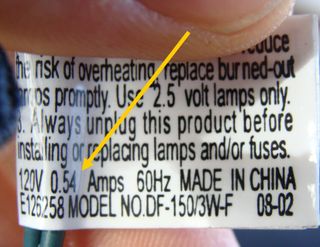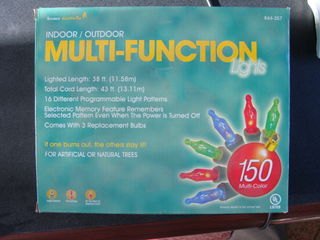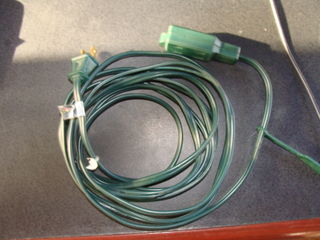There are plenty of web sites out there offering all the same basic advice on Christmas light safety; don’t use frayed cords, don’t use damaged lights, blah blah blah. I think most people know all this stuff. I was curious what could really pose a threat if you’re using new lights and new extension cords, so I thought I’d do a little math and figure it out.
As they say on the greatest TV show ever, ![]() : WARNING: SCIENCE CONTENT.
: WARNING: SCIENCE CONTENT.
As I see it, there are three main places for potential failure when installing Christmas lights – extension cords, power strips, and light cords. I’m assuming the lights will be plugged in to a standard 15 amp outlet, and nothing else is running on that circuit (lighting, TVs, radial arm saws, etc.).
Lights: I took a brand new string of 150 lights that I had sitting in my garage and examined the fine print on the warning label. As you can see, the lights draw .54 amps. This means that you could theoretically have 27 sets of lights plugged in to one circuit, and you would use 14.58 amps – just below the tripping point of a standard 15 amp breaker. Each string of lights has a 3 amp fuse built in to the plug, so you could potentially have five strings of lights plugged in to each other, end to end, to get 2.7 amps. For the record though, I’ve always heard that you shouldn’t use more than three.
Side note: If you noticed the date code on the lights “08-02”, you got me. These lights have been sitting in my garage for a long time. When stuff goes on clearance for 25 cents, I can’t help myself.
Side side note: On that string of lights from 2002 there was one warning label. Today, they have six warning labels. I’m sure this is totally necessary…
Power Strip: I just took a look at a cheap power strip that I had lying around in my basement, and was surprised to see that the power strip was rated for 15 amps. This means that the power strip should be able to deal with anything I plug in to it – if I overload it, the circuit breaker in my electric panel will trip.
Extension cord: I expected this to be the weakest link, but it’s not as weak as I thought; the smallest extension cord I could find online or in the store was rated for 13 amps. This means that if you plugged a power strip in to the end of the extension cord and ran 5 strings of lights (with 5 sets to a string), you would have a total of 25 sets pulling13.5 amps. This could start the extension cord on fire. Twenty-four sets of lights would probably be safe at 12.96 amps, giving you a total of 3,600 lights.
The bottom line? All the blah blah blah advice you hear is right on. As long as you’re using new lights, new extension cords and new power strips, you shouldn’t have much to worry about, and you shouldn’t have to do any math. Just remember to read the safety labels, and do some simple calculations if you think you’re using too many lights.
What if 3,600 lights isn’t enough? Of course, a lot of people ask me this, and I always tell them to buy LED lights. They’re hideously expensive, but they use 80% – 90% less power.
What about the heat from the lights? Mythbusters already tried setting a Christmas tree on fire using only the heat from the bulbs. It’s impossible. They ended up using a neon transformer to set a tree on fire.
Reuben Saltzman, Structure Tech Home Inspections – Email– Minnesota Home Inspections



